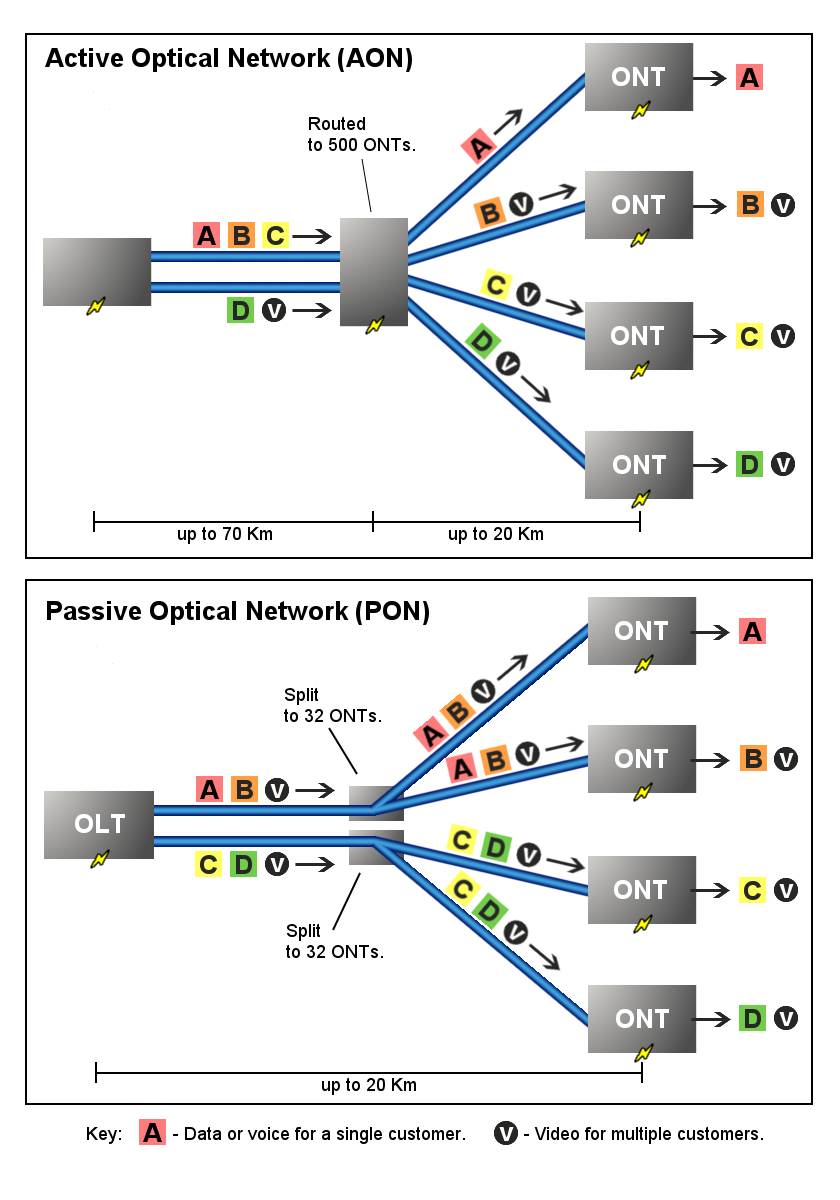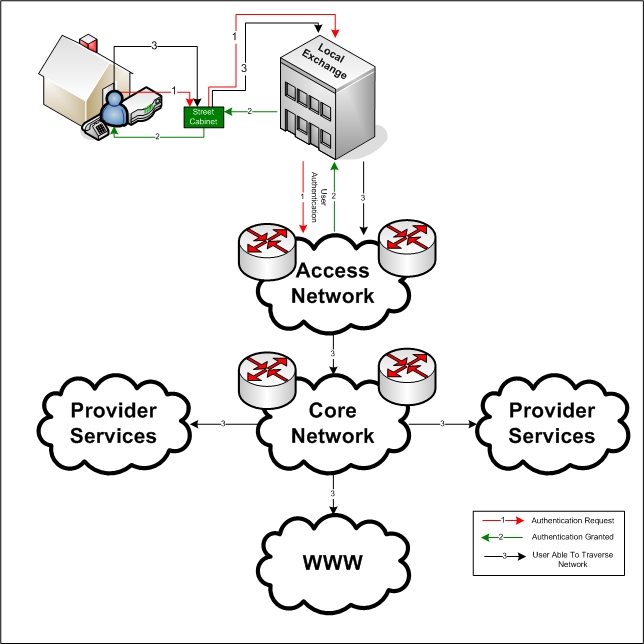|
G.983
ITU-T Recommendation G.983 is a family of recommendations that defines broadband passive optical network (BPON) for telecommunications Access_network#Optical_distribution_network, Access networks. It originally comprised ten recommendations, G.983.1 through G.983.10, but recommendations .6–.10 were withdrawn when their content was incorporated into G.983.2. The current view is that the BPON standards are mature, and no further work will be done on them after the 2007 round. The GPON OMCI definition has been revised to stand alone, rather than citing G.983.2. Although G.983 is directed at BPON, the GPON recommendations draw heavily on it, especially G.984.4, which defines the management model for GPON ONTs. Current recommendations The current recommendations are: G.983.1 Broadband optical access systems based on passive optical networks (PON), 2005, with amendment 1 and erratum 1. Includes the definition of the Churning (cipher), churning cipher. G.983.2 ONT management and ... [...More Info...] [...Related Items...] OR: [Wikipedia] [Google] [Baidu] |
Churning (cipher)
Churning is an encryption function used to scramble downstream user data of the ATM passive optical network system defined by the ITU G.983.1 standard. The standard states that churning "offers a low level of protection for data confidentiality". Cryptanalysis had shown that "the churning cipher is robustly weak". Algorithm Churning uses 24 bits of the key, designated X1..X8 and P1..P16. Ten static K bits are generated from the key: K1 = (X1×P13×P14) + (X2×P13×not P14) + (X7×not P13×P14) + (X8×not P13×not P14) K2 = (X3×P15×P16) + (X4×P15×not P16) + (X5×not P15×P16) + (X6×not P15×not P16) K3 = (K1×P9) + (K2×not P9) K4 = (K1×not P9) + (K2×P9) K5 = (K1×P10) + (K2×not P10) K6 = (K1×not P10) + (K2×P10) K7 = (K1×P11) + (K2×not P11) K8 = (K1×not P11) + (K2×P11) K9 = (K1×P12) + (K2×not P12) K10 = (K1×not P12) + (K2×P12) The churning transforms eight bits into eight bits: (Z1..Z4) = TransformNibble(Y1..Y4, K1, P1, K3, K2, P2, K4, K1, K3, K5, ... [...More Info...] [...Related Items...] OR: [Wikipedia] [Google] [Baidu] |
Passive Optical Network
A passive optical network (PON) is a fiber-optic telecommunications technology for delivering broadband network access to end-customers. Its architecture implements a point-to-multipoint topology in which a single optical fiber serves multiple endpoints by using unpowered (''passive'') fiber optic splitters to divide the fiber bandwidth among the endpoints. Passive optical networks are often referred to as the '' last mile'' between an Internet service provider (ISP) and its customers. Components and characteristics A passive optical network consists of an optical line terminal (OLT) at the service provider's central office (hub) and a number of optical network units (ONUs) or optical network terminals (ONTs), near end users. A PON reduces the amount of fiber and central office equipment required compared with point-to-point architectures. A passive optical network is a form of fiber-optic access network. In most cases, downstream signals are broadcast to all premises sharing ... [...More Info...] [...Related Items...] OR: [Wikipedia] [Google] [Baidu] |
ITU-T
The ITU Telecommunication Standardization Sector (ITU-T) is one of the three sectors (divisions or units) of the International Telecommunication Union (ITU). It is responsible for coordinating standards for telecommunications and Information Communication Technology such as X.509 for cybersecurity, Y.3172 and Y.3173 for machine learning, and H.264/MPEG-4 AVC for video compression, between its Member States, Private Sector Members, and Academia Members. The first meeting of the World Telecommunication Standardization Assembly (WTSA), the sector's governing conference, took place on 1 March of that year. ITU-T has a permanent secretariat called the Telecommunication Standardization Bureau (TSB), which is based at the ITU headquarters in Geneva, Switzerland. The current director of the TSB is Chaesub Lee (of South Korea), whose first 4-year term commenced on 1 January 2015, and whose second 4-year term commenced on 1 January 2019. Chaesub Lee succeeded Malcolm Johnson (Director), Malc ... [...More Info...] [...Related Items...] OR: [Wikipedia] [Google] [Baidu] |
NG-PON2
NG-PON2 (also known as TWDM-PON), ''Next-Generation Passive Optical Network 2'' is a 2015 telecommunications network standard for a passive optical network (PON). The standard was developed by ITU and details an architecture capable of total network throughput of 40 Gbit/s, corresponding to up to 10 Gbit/s symmetric upstream/downstream speeds available at each subscriber.{{Cite web, title=G.989: 40-Gigabit-capable passive optical networks (NG-PON2): Definitions, abbreviations and acronyms, url=https://www.itu.int/rec/T-REC-G.989, url-status=live, archive-url=https://web.archive.org/web/20210615123014/https://www.itu.int/rec/T-REC-G.989, archive-date=2021-06-15, access-date=2021-06-15, website=www.itu.int A passive optical network is a last mile, fibre-to-the-x telecommunications network that broadcasts data through fibre optic cables. PONs are managed by passive optics such as unpowered splitters and filters, offering high reliability and low cost compared to active networks. The ... [...More Info...] [...Related Items...] OR: [Wikipedia] [Google] [Baidu] |
GPON
G.984, commonly known as GPON (gigabit-capable passive optical network), is a standard for passive optical networks (PON) published by the ITU-T. It is commonly used to implement the outermost link to the customer (last kilometre or last mile) of fibre-to-the-premises (FTTP) services. GPON puts requirements on the optical medium and the hardware used to access it, and defines the manner in which ethernet frames are converted to an optical signal, as well as the parameters of that signal. The bandwidth of the single connection between the OLT (optical line termination) and the ONTs ( optical network terminals) is 2.4Gbit/s down, 1.2Gbit/s up, or rarely symmetric 2.4Gbit/s, shared between up to 128 ONTs using a time-division multiple access (TDMA) protocol, which the standard defines. GPON specifies protocols for error correction ( Reed–Solomon) and encryption ( AES), and defines a protocol for line control ( OMCI) which includes authentication. Though implementations of GPON sh ... [...More Info...] [...Related Items...] OR: [Wikipedia] [Google] [Baidu] |
ITU-T Recommendations
The ITU Telecommunication Standardization Sector (ITU-T) is one of the three sectors (divisions or units) of the International Telecommunication Union (ITU). It is responsible for coordinating standards for telecommunications and Information Communication Technology such as X.509 for cybersecurity, Y.3172 and Y.3173 for machine learning, and H.264/MPEG-4 AVC for video compression, between its Member States, Private Sector Members, and Academia Members. The first meeting of the World Telecommunication Standardization Assembly (WTSA), the sector's governing conference, took place on 1 March of that year. ITU-T has a permanent secretariat called the Telecommunication Standardization Bureau (TSB), which is based at the ITU headquarters in Geneva, Switzerland. The current director of the TSB is Chaesub Lee (of South Korea), whose first 4-year term commenced on 1 January 2015, and whose second 4-year term commenced on 1 January 2019. Chaesub Lee succeeded Malcolm Johnson of the United ... [...More Info...] [...Related Items...] OR: [Wikipedia] [Google] [Baidu] |
ITU-T Study Group 15
The ITU-T Study Group 15 (SG15) is a statutory group of the ITU Telecommunication Standardization Sector (ITU-T) concerned with networks, technologies and infrastructures for transport, access and home. It responsible for standards such as GPON, G.fast, etc. Administratively, SG15 is a statutory meeting of the World Telecommunication Standardization Assembly (WTSA), which creates the ITU-T Study Groups and appoints their management teams. The secretariat is provided by the Telecommunication Standardization Bureau (under Director Chaesub Lee). The goal of SG15 is to produce recommendations (international standards) for networks, See also *ITU-T The ITU Telecommunication Standardization Sector (ITU-T) is one of the three sectors (divisions or units) of the International Telecommunication Union (ITU). It is responsible for coordinating standards for telecommunications and Information Commu ... References External links ITU main siteITU-T Study Group 15 web site Internatio ... [...More Info...] [...Related Items...] OR: [Wikipedia] [Google] [Baidu] |
10G-PON
10G-PON (also known as XG-PON or G.987) is a 2010 computer networking standard for data links, capable of delivering shared Internet access rates up to 10 Gbit/s (gigabits per second) over existing dark fiber. This is the ITU-T's next generation standard following on from GPON or Gigabit-capable PON. Optical fibre is shared by many subscribers in a network known as FTTx in a way that centralises most of the telecommunications equipment, often displacing copper phone lines that connect premises to the phone exchange. Passive optical network (PON) architecture has become a cost-effective way to meet performance demands in access networks, and sometimes also in large optical local networks for "Fibre-to-the-desk". Passive optical networks are used for the "Fibre-to-the-home" or "Fibre-to-the-premises" last mile with splitters that connect each central transmitter to many subscribers. The 10 Gbit/s shared capacity is the downstream speed broadcast to all users connected t ... [...More Info...] [...Related Items...] OR: [Wikipedia] [Google] [Baidu] |
Telecommunication
Telecommunication is the transmission of information by various types of technologies over wire, radio, optical, or other electromagnetic systems. It has its origin in the desire of humans for communication over a distance greater than that feasible with the human voice, but with a similar scale of expediency; thus, slow systems (such as postal mail) are excluded from the field. The transmission media in telecommunication have evolved through numerous stages of technology, from beacons and other visual signals (such as smoke signals, semaphore telegraphs, signal flags, and optical heliographs), to electrical cable and electromagnetic radiation, including light. Such transmission paths are often divided into communication channels, which afford the advantages of multiplexing multiple concurrent communication sessions. ''Telecommunication'' is often used in its plural form. Other examples of pre-modern long-distance communication included audio messages, such as coded drumb ... [...More Info...] [...Related Items...] OR: [Wikipedia] [Google] [Baidu] |
Broadband
In telecommunications, broadband is wide bandwidth data transmission which transports multiple signals at a wide range of frequencies and Internet traffic types, that enables messages to be sent simultaneously, used in fast internet connections. The medium can be coaxial cable, optical fiber, wireless Internet (radio), twisted pair or satellite. In the context of Internet access, broadband is used to mean any high-speed Internet access that is always on and faster than dial-up access over traditional analog or ISDN PSTN services. Overview Different criteria for "broad" have been applied in different contexts and at different times. Its origin is in physics, acoustics, and radio systems engineering, where it had been used with a meaning similar to "wideband", or in the context of audio noise reduction systems, where it indicated a single-band rather than a multiple-audio-band system design of the compander. Later, with the advent of digital telecommunications, the term was mainly ... [...More Info...] [...Related Items...] OR: [Wikipedia] [Google] [Baidu] |
Telecommunications
Telecommunication is the transmission of information by various types of technologies over wire, radio, optical, or other electromagnetic systems. It has its origin in the desire of humans for communication over a distance greater than that feasible with the human voice, but with a similar scale of expediency; thus, slow systems (such as postal mail) are excluded from the field. The transmission media in telecommunication have evolved through numerous stages of technology, from beacons and other visual signals (such as smoke signals, semaphore telegraphs, signal flags, and optical heliographs), to electrical cable and electromagnetic radiation, including light. Such transmission paths are often divided into communication channels, which afford the advantages of multiplexing multiple concurrent communication sessions. ''Telecommunication'' is often used in its plural form. Other examples of pre-modern long-distance communication included audio messages, such as coded drumb ... [...More Info...] [...Related Items...] OR: [Wikipedia] [Google] [Baidu] |
Access Network
An access network is a type of telecommunications network which connects subscribers to their immediate service provider. It is contrasted with the core network, which connects local providers to one another. The access network may be further divided between feeder plant or distribution network, and drop plant or edge network. Telephone heritage An access network, also referred to as an outside plant, refers to the series of wires, cables and equipment lying between a consumer/business telephone termination point (the point at which a telephone connection reaches the customer) and the local telephone exchange. The local exchange contains banks of automated switching equipment which direct a call or connection to the consumer. The access network is perhaps one of the oldest assets a telecoms operator would own. In 2007–2008 many telecommunication operators experienced increasing problems maintaining the quality of the records which describe the network. In 2006, according t ... [...More Info...] [...Related Items...] OR: [Wikipedia] [Google] [Baidu] |



